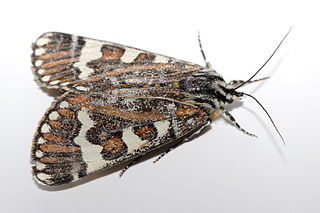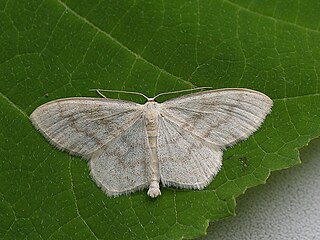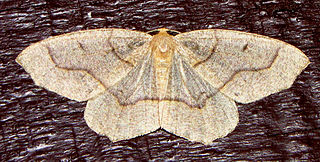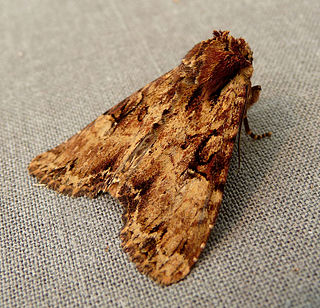
The pasture day moth, Apina callisto, is a species in the moth family Noctuidae which is active during the day, as its common name implies, making it unlike most other noctuid species. It is found in most southern areas of Australia, ranging from lower Queensland to Tasmania. The species was first described by George French Angas in 1847. It is the only species in the monotypic genus Apina, erected by Francis Walker in 1855.

The lunar underwing is a moth of the family Noctuidae. The species was first described by Adrian Hardy Haworth in 1809. It has a scattered distribution in western Europe including Spain, Scandinavia and Algeria.

The cream wave is a moth of the family Geometridae. The species was first described by Adrian Hardy Haworth in 1809. It is found in forest and woodland regions, feeding on grasses and small plants such as dandelion.

Orthonama obstipata, the gem, is a moth of the family Geometridae. The species was first described by Johan Christian Fabricius in 1794. It is a cosmopolitan species. In continental Europe though in the northeast, its range does not significantly extend beyond the Baltic region and it is absent from northern Russia. This well-flying species is prone to vagrancy and able to cross considerable distances of open sea; it can thus be regularly found on the British Isles and even on Iceland.

Agriphila geniculea, the elbow-striped grass-veneer, is a species of moth of the family Crambidae. It was first described by Adrian Hardy Haworth in 1811.

Nudaria is a genus of moths in the subfamily Arctiinae erected by Adrian Hardy Haworth in 1809.

Lambdina fiscellaria, the mournful thorn or hemlock looper, is a moth of the family Geometridae. It is found in North America, from the Pacific to the Atlantic coast and from Canada south to Pennsylvania, Wisconsin and California.

Euclidia cuspidea, the toothed somberwing, is a moth of the family Erebidae. The species was first described by Jacob Hübner in 1818. It is found in North America from Quebec west to western Alberta, north to the Northwest Territories and south to the Gulf of Mexico.

Caenurgina is a genus of moths in the family Erebidae.

Caenurgina annexa, the banded grass moth, is a moth of the family Erebidae. The species was described by Henry Edwards in 1890. It is found in western North America from western Alberta and Montana to British Columbia, Washington, and Oregon.

Caenurgina erechtea, the forage looper or common grass moth, is a moth of the family Erebidae. The species was first described by Pieter Cramer in 1780. It is found from coast to coast in the United States and adjacent parts of Canada. It is not found in Newfoundland, New Brunswick, Prince Edward Island, Yukon, or the Northwest Territories. The wingspan is 30–42 mm. Adults are on wing from March to November depending on the location.

Caenurgina caerulea, the cerulean looper moth, is a moth of the family Erebidae. It is found in large parts of North America, including California, and British Columbia.

Drasteria grandirena, the figure-seven moth or great kidney, is a moth of the family Erebidae first described by Adrian Hardy Haworth in 1809. It is found in North America from Ontario, Quebec and Nova Scotia, south to at least Georgia west to at least Arkansas

Hypagyrtis unipunctata, the one-spotted variant moth or white spot, is a moth of the family Geometridae. The species was first described by Adrian Hardy Haworth in 1809. It can be found from Nova Scotia to Florida, west to Texas, northwest to British Columbia on the North American continent, and is also found in Eurasia.

Scopula limboundata, the large lace-border, is a moth of the family Geometridae. It was described by Adrian Hardy Haworth in 1809. It is found in North America east of the Rocky Mountains. There is a single and unconfirmed record from Great Britain.

Apamea oblonga, the crescent striped, is a moth of the family Noctuidae. The species was first described by Adrian Hardy Haworth in 1809. It is found in northern and central Europe, east to southern Russia, Asia Minor, Armenia, Turkestan, Turkey, Iran, southern Siberia, northern Pakistan, Mongolia, China, Sakhalin and Japan

Apamea epomidion, the clouded brindle, is a moth of the family Noctuidae, sub-family Hadeninae. The species was first described by Adrian Hardy Haworth in 1809. It is found throughout continental Europe, the British Isles, Sweden and Central Asia. It is also found in the Altai Mountains, west Siberia, and in Amur.

Mesoligia literosa, the rosy minor, is a moth of the family Noctuidae. The species was first described by Adrian Hardy Haworth in 1809. It is found throughout Europe, North Africa and western Asia. and east across the Palearctic to Siberia.
Eudonia vinasalis is a moth in the family Crambidae. It was described by Harrison Gray Dyar Jr. in 1929. It is found in Costa Rica.


















